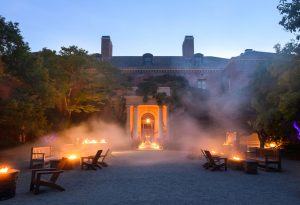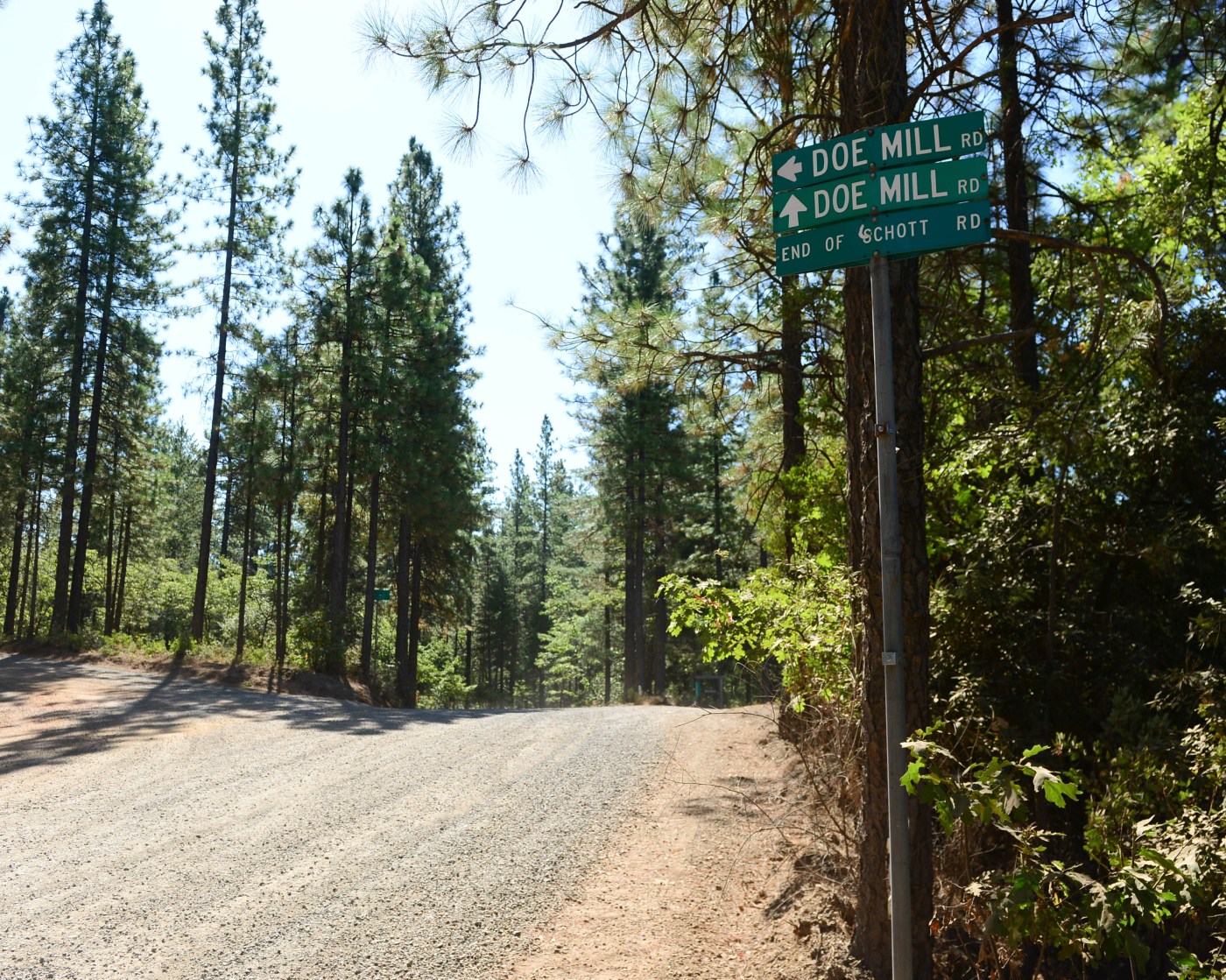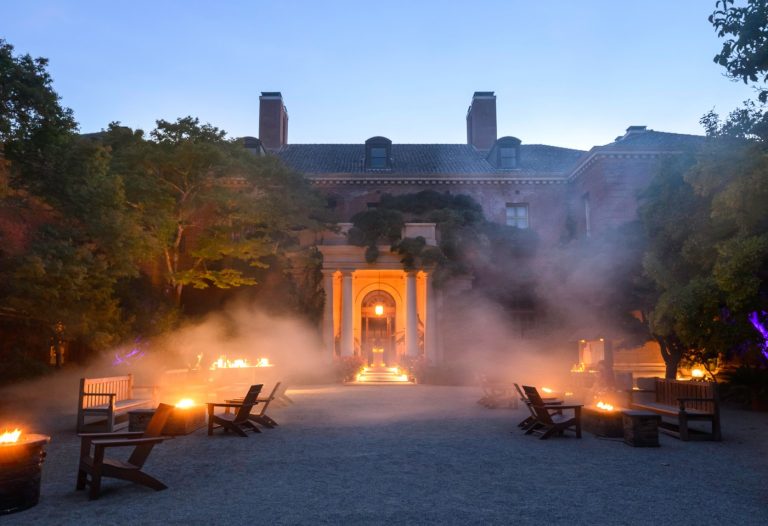FOREST RANCH — Each year Butte County fields dozens of requests to take on what were previously private roads, but seldom does it make it to the Board of Supervisors.
One such road southeast of Forest Ranch found itself on the agenda for Tuesday’s Butte County Board of Supervisors meeting after concerns were raised by some who had to use the road as an evacuation route during the Park Fire.
Doe Mill Road spans a lengthy portion of Butte County from Blue Shirt Drive north, crossing Butte Creek and returning south toward Powellton Road. Supervisor Doug Teeter received head nods from his fellow supervisors during the Sept. 10 meeting to request information from Public Works Director Joshua Pack regarding the means of bringing the roadway onto the county’s maintained mileage.
Doe Mill Road runs to the right of where Schott Road goes straight according to the road sign Wednesday, Sept. 25, 2024 in Forest Ranch, California. (Dan Reidel/Enterprise-Record)
The focus was specifically on a portion of Doe Mill Road between Garland and Schott roads.
“(There are) not a lot of county-maintained roads in this area, though there are several other sections of Doe Mil Road we do maintain,” Pack said. “We also maintain Schott and Garland. This action would in essence create a county-maintained loop that would connect to two different locations along Highway 32.”
There are 12 privately owned properties along the stretch of Doe Mill Road, two of which are owned by the Bureau of Land Management and one by Sierra Pacific Industries. The county occasionally uses the roads and applies minimal maintenance.
If the county were to take on the portion of the road, it would cost roughly $32,000 a year, Pack said.
“We do occasionally do some light maintenance, especially if we’re driving through there,” Pack said. “We don’t spend a lot of time, but if we are driving through, we might drop a blade or add a little bit of material.”
Pack brought up two issues when considering the transfer of the road. The first was that the road in its current state doesn’t live up to county standards, meaning adopting the road could be a liability to the county should an incident occur. The second is that it doesn’t meet the criteria of serving a regional role as a collector road, an arterial road or an emergency outlet.
“It’s not denying that the road is used for emergency purposes, most all roads are done for that,” Pack said. “This is not included in any adopted or emergency travel plan.”
Skeptical, the board opted to send Pack out to obtain more information, while also asking residents requesting the adoption to come up with a plan going forward. The plan is for Public Works staff to reach out to property owners to get a pulse of what will be possible.
Discussion
Andrew Logan, a resident in the area, was the first to speak during the public comment period on Tuesday.
“The access into the portions that have structures on them becomes important for the simple fact that four to six minutes saves lives,” Logan said. “I appreciate that it costs $32,000 to provide work on the road; at the same time, as Doug Teeter said, ‘We don’t want dead people.’”
Caitlin Dalby, chair of the Forest Ranch Fire Safe Council, told the board that the request goes beyond that of residents living near Doe Mill Road.
“The property owners aren’t the only ones who have been asking for this, the community has been asking for this,” Dalby said. “We met with the county when the evacuation routes were being done earlier this year, and we cumulatively have asked for Doe Mill Road to be considered as part of the evacuation route — and we watched it play out in real-time when we had residents get stuck on that side of Schott Road during the Park Fire because of the direction that the fire came in.”
Supervisor Bill Connelly said he wouldn’t support the county taking on the roadway unless residents and community members come together to formulate a plan to pay for or help pay for the maintenance as well as bringing the roadway up to county standards.
“They have to form their own group and tax themselves or get a bond, bring it to a county standard then we take it over, if we make an exception and do it here, I’ve got at least 10 places I can bring to you that are going to want the same exception.”
What it would take
There is a well-defined process for adding a new road into the county’s maintained mileage system. Pack said the county can’t simply deem a road as being under the county’s maintenance umbrella.
“Without the rights to necessarily assume the property rights in order to provide this service, we can’t wave a magic wand and claim that we can now maintain that road using public taxpayer dollars,” Pack said. “To do so and to incur responsibility over property that we don’t have the rights to could be considered an illegal taking.”
It is possible that the county accepts offers of dedication that go back to the 1970s that were denied by previous boards.
“Those are 50 years old but are still technically out there,” Pack said. “It’s a little rare to accept offers that have been dormant for 50 years, but it’s certainly not without precedent.”
However, even if the county were to go this route, it would still need to procure the rights from other owners including the Bureau of Land Management and Sierra Pacific Industries.
“I’ve done several maintenance agreements with (the Bureau of Land Management) and they tend to be one of the more difficult federal agencies to deal with but there is precedent for doing that,” Pack said.
If the county were able to obtain these properties, it would then come down to the residents living on that stretch and whether they would unanimously support the takeover, which as Pack stated, is rare.
Private or Public?
One of the key points of concern during the discussion revolved around whose jurisdiction the road was under. While the roadway isn’t public, the term private doesn’t necessarily cover it either.
Pack noted that the road exists under a non-exclusive easement for road and utility purposes, meaning that it isn’t county-maintained but allows for public usage.
“It’s a term that’s not used much anymore,” Pack said of the non-exclusive easement, adding that he reached out to local surveyors to understand the context. “…We all kind of landed on the consensus that this means it’s basically a public thoroughfare, residents can’t construct gates or limit access but it was never intended to be included in the maintained mileage system.”
Related Articles
Butte County to clear up fire fuel with federal grants
Butte County supervisors to discuss vegetation management
Hazardous waste removal to begin in Thompson Fire burn scar
Supervisors approve Behavioral Health building purchase, future rennovations
Supervisors to consider building purchase for Behavioral Health
Much like a private road, the county has no jurisdiction over it, nor does it have any responsibility to maintain it, but unlike private roads, residents living on it have no ability to alter it or place restrictions.
Pack said he was unsure as to why the road was designated that way, but Connelly provided his best guess.
“This came about because it was cheaper for the person doing the subdividing of the land to not provide a county-maintained road,” Connelly said. “So he didn’t have to bring it or she didn’t have to bring it to a county standard. That’s why it wasn’t brought to a county standard. It was to save money.”











+ There are no comments
Add yours